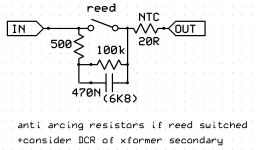i could find only kill-o-volt reeds capable of swithing of few amps (and some power RF types)Unless the capacitors are fully charged I'd think it'll work. Otherwise, I still think the contacts will stick. It doesn't take much to exceed 3A. It'll be interesting to see how this turns out. That's still an impressive reed relay.
Attachments
To the OP: Have you got a chance to try this out? I'm wondering how the reed relay worked out for you.
To the OP: Have you got a chance to try this out? I'm wondering how the reed relay worked out for you.
Not yet, I've got some parts on the way. Some experimentation is in order.
Besides the capacitor inrush, I was quite shocked by the amount of inrush the primary winding of the power transformer presented at switch on (no flux so only DC resistance). Inrush limiting at the primary suddenly looked more attractive then before (where the relay becomes less of an issue anyway). I'm now looking if primary inrush limiting is enough, or it should be a combination at both sides of the transformer.
Once the parts arrive, I'll keep you up to date.
It's just dawned on me. Why not split the resistor in two so that two resistors each have half the voltage across them. Then use a relay across each resistor. It ups the component count but negates the voltage issue.
for inrush exist one nice device,
MS22 22103 AMETHERM - Termistor NTC | Transfer Multisort Elektronik
MS22 22103 AMETHERM - Termistor NTC | Transfer Multisort Elektronik
No go. Unless both switch simultaneously, there's a transient across the one that switches last.It's just dawned on me. Why not split the resistor in two so that two resistors each have half the voltage across them. Then use a relay across each resistor. It ups the component count but negates the voltage issue.
Well , I finally got the parts in and had time to experiment. The winner is the Ametherm SL22 12103. A 120 ohm, 3 amp NTC, supposedly specifically designed for power amps (but I can't see why it would limit itself to that).
The NTC is placed in the primary and bypassed after a few seconds (have to determine the optimal time) by a relay to stop the heat production, allow it to cool down and get rid of any remaining voltage drop across it. Oscilloscope tests show the inrush is limited to around 2 amps rms and gradually lowers until it reaches its stable condition where the caps are full and heaters are warm.
It's perfect. Low parts count, no big power resistors, and it limits ALL inrush currents, cold heaters, empty caps and transformers without flux included.
Thanks again for all info and suggestions. The ones I didn't use still gave me plenty to think about!
The NTC is placed in the primary and bypassed after a few seconds (have to determine the optimal time) by a relay to stop the heat production, allow it to cool down and get rid of any remaining voltage drop across it. Oscilloscope tests show the inrush is limited to around 2 amps rms and gradually lowers until it reaches its stable condition where the caps are full and heaters are warm.
It's perfect. Low parts count, no big power resistors, and it limits ALL inrush currents, cold heaters, empty caps and transformers without flux included.
Thanks again for all info and suggestions. The ones I didn't use still gave me plenty to think about!
Adding some heatshrink tube over the part can assist in mopping up if ever the part fails. Encapsulation of the part would not meet safety requirement, so the heatshrink sort of helps on that issue as well. Similar to a mains MOV situation. Perhaps trivial concerns, but an easy addition.
Thanks for the update. So many never return to tell how things went. I figured the ICL would be the best choice, but I really wanted to know how the reed relay would have worked.Well , I finally got the parts in and had time to experiment. The winner is the Ametherm SL22 12103. A 120 ohm, 3 amp NTC, supposedly specifically designed for power amps (but I can't see why it would limit itself to that).
- Status
- Not open for further replies.
- Home
- Amplifiers
- Tubes / Valves
- Relays for tube voltages
